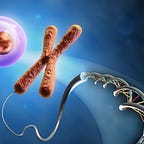Architecture of Chromosomes
Architecture of Chromosomes is the way the DNA molecules are arranged in the nucleoid of the cytoplasm of the prokaryotic cells or in the nucleus of eukaryotic cells.
DNA of both prokaryotic and eukaryotic cells are called Chromosomes. However , true chromosomes are present only in eukaryotes.
Prokaryotic chromosomes is a single double stranded circular DNA molecule associated with a few protein molecules. Eukaryotes have several chromosomes, each consisting of a single double stranded linear DNA associated with histones and other proteins molecules.
When the size of all chromosomes of all organisms are considered, it is an enormous amount of DNA. These facts illustrates that, a cell has a huge problem in having it’s DNA either in the nucleoid of the prokaryotes or the nucleus of eukaryotes. Containment of the genome/DNA in the nucleus or in the nucleus is called DNA packaging.
Packaging of DNA in prokaryotes is facilitated by the proteins associated with the DNA molecule.The protein molecules cause the DNA to coil (or fold or loop) and supercoil, so the DNA moleculeis compacted into the nucleoid. The DNA molecule is initially coiled into loops and these loops then independently supercoil into domains identifiable in electron micrographs. The loops of compacted mass of DNA are bound to a 'core' consisting of RNA and protein. The 'core' also attaches the chromosome to the membrane. The supercoiled DNA can be relaxed by introducing single strand nicks. Since the chromosomes are attached to the membrane and held together by the 'core’acting as a barrier for rotation, the domains can relax and supercoil independently.This is important in the transcription of specific genes. Removal of RNA will lead to loss of independence of the loops.
In addition to the chromosomal DNA, Certain prokaryotes have extra chromosomal genetic elementa Called “ Plasmids ”. They are also circular DNA and are coiled and supercoiled.
Eukaryotic chromosomes are associated with a large number of proteins called histones that helps
to organize the DNA inside the nucleus. This DNA-protein complex is known as chromatin. The chromatin may be lightly packed as in Euchromatin or tightly packed as in Heterochromatin. Euchromatin is rich in genes and is probably active in transcription. Heterochromatin consists
nucleotide sequences which are mostly inactive. They may contribute in gene regulation, epigenetic inheritance and protection from chromosomal integrity. In the first level, the double helix winds around a complex of eight histone molecules. These are called nucleosomes and they look like beads of a necklace. The adjoining beads of nucleosomes
are linked together by a stretch of DNA: linker DNA.
In the second level, the nucleus twist and pack in a spiral fashion to form a chromatin fiber of roughly 30nm in diameter: 30nm fibera from 10nm fibers.
At the third level, the 30 nm fiber forms loops, called looped domains, attached to a protein scaffold. This structure has a thickness of 300 nm.
Finally, at the fourth level, the looped domains coil, fold and further compact to form the mitotic chromosome. The diameter of a chromatid is about 700 nm. In the metaphase chromosome, the chromatids are already replicated.
